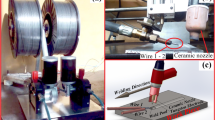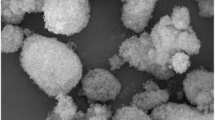Abstract
Flux cored arc welding (FCAW) process is a fusion welding process in which the welding electrode is a tubular wire that is continuously fed to the weld area. It is widely used in industries and shipyards for welding heavy plates. Welding input parameters play a very significant role in determining the quality of a weld joint. This paper addresses the simulation of weld bead geometry in FCAW process using artificial neural networks (ANN) and optimization of process parameters using particle swarm optimization (PSO) algorithm. The input process variables considered here include wire feed rate (F); voltage (V); welding speed (S) and torch Angle (A) each having 5 levels. The process output characteristics are weld bead width, reinforcement and depth of penetration. As per the statistical design of experiments by Taguchi L25 orthogonal array, bead on plate weldments were made. The experimental results were fed to the ANN algorithm for establishing a relationship between the input and output parameters. The results were then embedded into the PSO algorithm which optimizes the process parameters subjected to the objectives. In this study the objectives considered are maximization of depth of penetration, minimization of bead width and minimization of reinforcement.
Similar content being viewed by others
References
Aloraier A., Ibrahim R., Thomson P. (2006) FCAW process to avoid the use of post weld heat treatment. International Journal of Pressure Vessels and Piping 83: 394–398
Benyounis K.Y., Olabi A.G. (2008) Optimization of different welding processes using statistical and numerical approaches—A reference guide. Advances in Engineering Software 39: 483–496
Benyounis, K. Y., Olabi, A. G., & Hashmi, M. S. J. (2005). Optimizing the laser-welded butt joints of medium carbon steel using RSM. Journal of Materials Processing Technology, 164–165, 986–989.
Benyounis, K. Y., Olabi, A. G., & Hashmi, M. S. J. (2005). Effect of laser welding parameters on the heat input and weld-bead profile. Journal of Materials Processing Technology, 164–165, 978–985.
Connor L. P. (1991) Welding handbook-welding processes. American Welding Society, Miami
Correia D. S., Gonçalves C. V., Cunha S. S. Jr., Ferraresi V. A. (2005) Comparison between genetic algorithms and response surface methodology in GMAW welding optimization. Journal of Materials Processing Technology 160: 70–76
Eberhart, R. C., & Kennedy, J. (1995). A new optimizer using particle swarm theory. In Proceedings of the sixth international symposium on micro machine and human science. IEEE service center, Piscataway, NJ, Nagoya, Japan, pp. 39–43.
Ghazvinloo, H. R., & Honarbakhsh Raouf, A. (2010). Effect of Gas-Shielded flux cored arc welding parameters on weld width and tensile properties of weld metal in a low carbon steel. Journal of Applied Sciences, ISSN 1812–5654.
Ghazvinloo, H. R., & Honarbakhsh Raouf, A. (2010). Influence of wire feeding speed, welding speed and preheating temperature on hardness and microstructure of weld of RQT 701-British steel produced by FCAW. Indian Journal of Science and Technology, 3(5), ISSN: 0974-6846.
Jeffus L. (2004) Welding principles and applications (5th ed.). Delmar Publication, New York
Juang S. C., Tarng Y. S. (2002) Process parameter selection for optimizing the weld pool geometry in the tungsten inert gas welding of stainless steel. Journal of Materials Processing Technology 122: 33–37
Kannan T., Murugan N. (2006) Effect of flux cored arc welding process parameters on duplex stainless steel clad quality. Journal of Materials Processing Technology 176: 230–239
Kim I. S., Son J. S., Kim I. G., Kim J. Y., Kim O. S. (2003) A study on relationship between process variables and bead penetration for robotic CO2 arc welding. Journal of Materials Processing Technology 136: 139–145
Kim, I. S., Son, J. S., Park, C. E., Lee, C. W., & Prasad, K. D. V. (2002). A study on prediction of bead height in robotic arc welding using a neural network. Journal of Materials Processing Technology, 130–131, 229–234.
Malinov S., Sha W., McKeown J. J. (2001) Modelling the correlation between processing parameters and properties in Titanium alloys using artificial neural network. Computational Materials Science 21: 375–394
Massie, D. D. (2001). ECOS 2001. In: Gogus, Y. A., Ozturk, A., (Eds.), First international conference on applied thermodynamics, Istanbul, Turkey.
Nagesh D. S., Datta G. L. (2010) Genetic algorithm for optimization of welding variables for height to width ratio and application of ANN for prediction of bead geometry for TIG welding process. Applied Soft Computing 10: 897–907
Nouri M., Abdollah-zadehy A., Malek F. (2007) Effect of welding parameters on dilution and weld bead geometry in cladding. Journal of Material Science and Technology 23: 817–822
Poli R., Kennedy J., Blackwell T. (2007) Particle swarm optimization: An overview. Swarm Intelligence 1: 33–57
Radaj D. (1992) Heat effects of welding—temperature field, residual stress. Springer, Distortion
Shi X. H., Liang Y.C., Lee H. P., Lu C., Wang Q. X. (2007) Particle swarm optimization-based algorithms for TSP and generalized TSP. Information Processing Letters 103: 169–176
Veera Babu K., Ganesh Narayanan R., Saravana Kumar G. (2009) An expert system based on artificial neural network for predicting the tensile behavior of tailor welded blanks. Expert Systems with Applications 36: 10683–10695
Woo L., Kikuchi Y. (2002) Metallurgical and mechanical properties of high nitrogen austenitic stainless steel friction welds. Iron & Steel Institute of Japan Journal International 42(4): 401–406
Xue, Yu., Kim, I. S., Son, J. S., Park, C. E., Kim, H. H., Sung, B. S., et al. (2005). Fuzzy regression method for prediction and control the bead width in the robotic arc-welding process. Journal of Materials Processing Technology, 164–165, 1134–1139.
Yilmaz R., Tumer M. (2010) The effect of shielding gases on the microstructure and toughness of stainless steels weldments by FCAW. International Conference of the International Institute of Welding 10(85): 847–852
Author information
Authors and Affiliations
Corresponding author
Rights and permissions
About this article
Cite this article
Katherasan, D., Elias, J.V., Sathiya, P. et al. Simulation and parameter optimization of flux cored arc welding using artificial neural network and particle swarm optimization algorithm. J Intell Manuf 25, 67–76 (2014). https://doi.org/10.1007/s10845-012-0675-0
Received:
Accepted:
Published:
Issue Date:
DOI: https://doi.org/10.1007/s10845-012-0675-0




